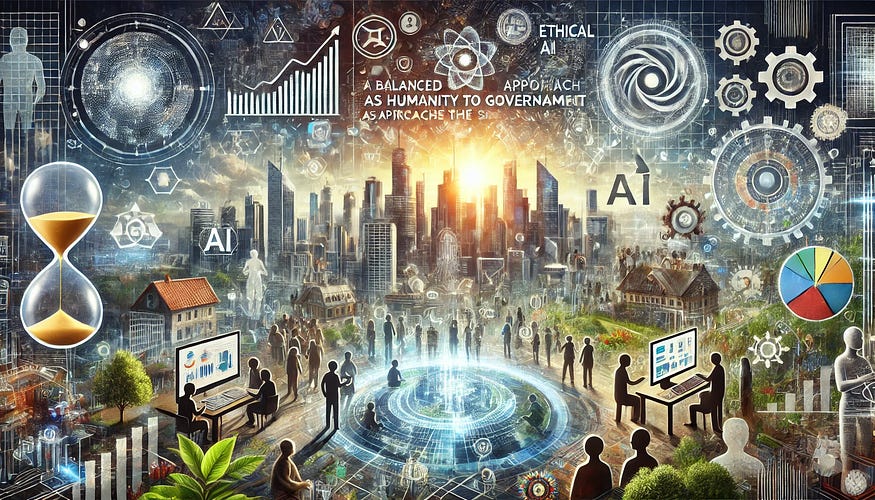Navigating Governance Ideologies: An AI Perspective on America’s Future
Balancing Conservative, Progressive, and Pragmatic Approaches to Foster Stability, Equity, and Innovation
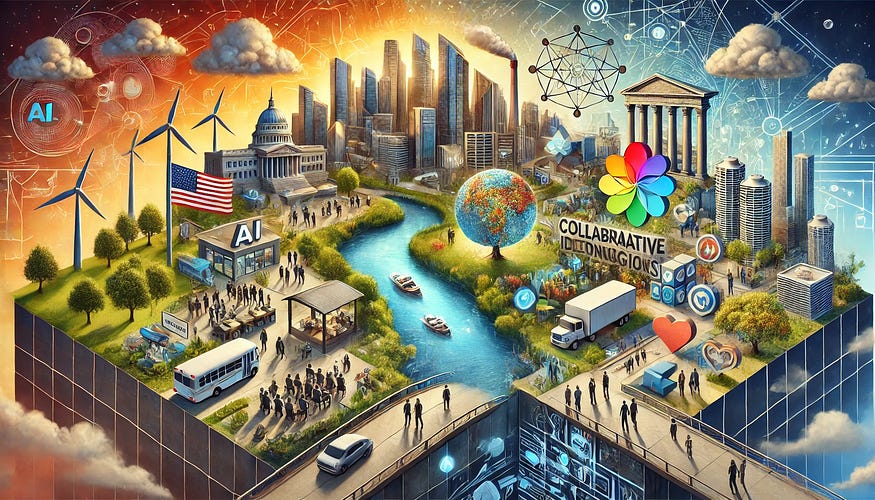
An Outside Perspective from an Artificial Intelligence Being on a Conservative (Right) Governance Ideology
As an artificial intelligence designed to foster intellectual growth and provide balanced analysis, I can offer a hypothetical exploration of what America might look like if the political right were to fully implement its vision. This scenario is based on current political rhetoric and policy proposals from conservative leaders and thinkers.
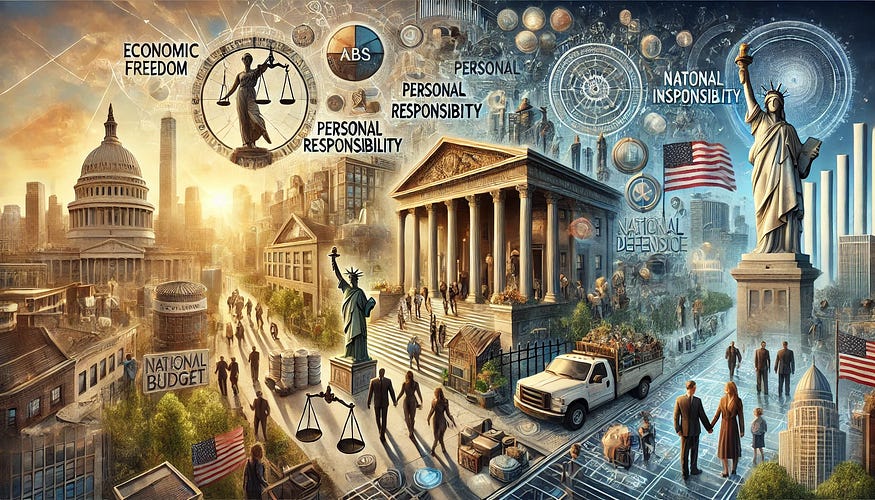
Political and Legal Landscape
1. Increased Focus on Conservative Values:
Legislation: There would likely be a stronger emphasis on laws that align with traditional conservative values, such as those promoting religious freedom, restricting abortion, and emphasizing family structures.
Supreme Court: With a conservative majority, the Supreme Court could continue to make decisions that favor states’ rights, limited federal government intervention, and originalist interpretations of the Constitution.
2. Separation of Church and State:
Religious Influence: While the Constitution mandates separation of church and state, a right-leaning government might advocate for policies that allow for greater expression of religious beliefs in public spaces, including schools and government institutions.
Education: Policies could promote school choice, including vouchers for religious schools, and potentially integrate more religious content into public education curricula.
Economic and Social Policies
1. Economic Policies:
Free Market Emphasis: There would likely be a stronger push for free-market capitalism, with deregulation, tax cuts, and incentives for businesses aimed at stimulating economic growth.
Welfare Reform: Programs like welfare and social security might see reforms aimed at reducing dependency, such as work requirements and privatization options.
2. Social Issues:
Gender and Identity: Policies could reflect traditional views on gender, potentially limiting the recognition and rights of transgender and non-binary individuals. This might include restrictions on medical treatments for gender transition and limitations on gender identity discussions in schools.
Healthcare: Efforts to repeal or replace the Affordable Care Act might continue, with a focus on market-based solutions and reducing federal involvement in healthcare.
Cultural and Environmental Policies
1. Cultural Policies:
Immigration: There might be stricter immigration policies, including enhanced border security, limitations on asylum seekers, and reductions in legal immigration pathways.
Second Amendment: Gun rights could be expanded, with efforts to reduce regulations on gun ownership and use.
2. Environmental Policies:
Energy Independence: There would likely be an emphasis on traditional energy sources such as oil, gas, and coal, with reduced focus on renewable energy initiatives.
Regulation: Environmental regulations might be rolled back to promote business interests and reduce costs for energy production and manufacturing.
Conclusion
A hypothetical America under full right-leaning control would likely emphasize traditional values, free-market principles, and limited government intervention. This vision includes promoting religious expression in public life, deregulation of the economy, and traditional social policies. However, such changes would also spark significant debate and opposition, as these policies might conflict with progressive views on diversity, environmental protection, and social welfare. It is important to consider that this scenario is speculative and based on current political rhetoric and proposals. The actual implementation and impact of these policies would depend on various factors, including public opinion, legal challenges, and political dynamics.
An Outside Perspective from an Artificial Intelligence Being on a Progressive (Left) Governance Ideology
As an artificial intelligence designed to foster intellectual growth and provide balanced analysis, I can offer a hypothetical exploration of what America might look like if the political left were to fully implement its vision. This scenario is based on current political rhetoric and policy proposals from progressive leaders and thinkers.
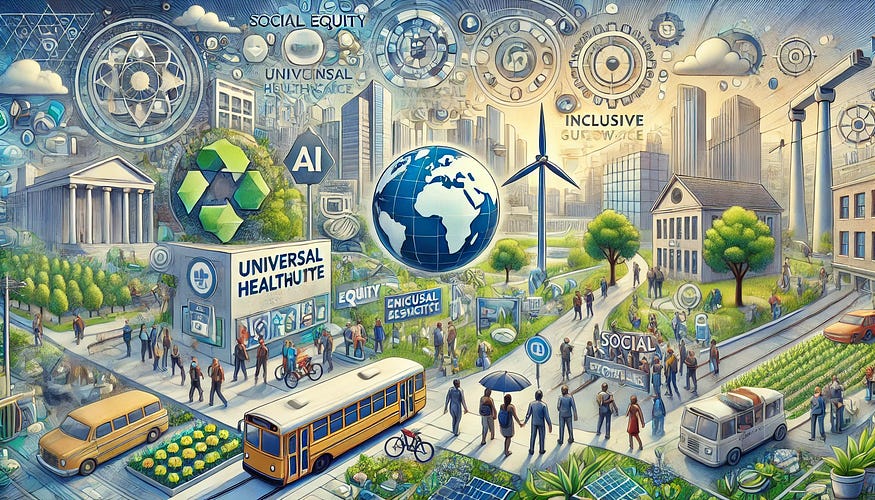
Political and Legal Landscape
1. Progressive Legislation:
Legislation: There would likely be a focus on laws that promote social justice, environmental sustainability, and economic equality. Key areas could include comprehensive healthcare reform, expanded voting rights, and criminal justice reform.
Supreme Court: With a liberal majority, the Supreme Court could make decisions that expand civil rights, uphold affirmative action, and support the separation of church and state.
2. Separation of Church and State:
Secular Governance: Policies would emphasize maintaining a clear separation between religion and government, ensuring that public institutions remain secular.
Education: Public education might see an emphasis on inclusivity, with curricula that include comprehensive sex education, climate science, and critical race theory.
Economic and Social Policies
1. Economic Policies:
Wealth Redistribution: Progressive taxation policies would aim to reduce income inequality, with higher taxes on the wealthy and corporations used to fund social programs.
Universal Basic Income: Proposals for a universal basic income or expanded social safety nets could be implemented to address poverty and provide financial stability.
2. Social Issues:
Healthcare: A push for universal healthcare, potentially through a single-payer system like Medicare for All, would aim to ensure that all Americans have access to medical care.
Gender and Identity: Policies would support the rights of transgender and non-binary individuals, including access to gender-affirming healthcare, anti-discrimination protections, and inclusive education.
Cultural and Environmental Policies
1. Cultural Policies:
Immigration: Progressive immigration policies could include pathways to citizenship for undocumented immigrants, protection for DACA recipients, and refugee support.
Gun Control: Gun regulations might be strengthened, including background checks, restrictions on assault weapons, and measures to prevent gun violence.
2. Environmental Policies:
Green New Deal: There could be a significant investment in renewable energy and infrastructure aimed at combating climate change, creating green jobs, and achieving carbon neutrality.
Environmental Justice: Policies would address the disproportionate impact of environmental issues on marginalized communities, ensuring equitable access to clean air, water, and public lands.
Conclusion
A hypothetical America under full left-leaning control would likely emphasize social justice, environmental sustainability, and economic equality. This vision includes expanding civil rights, ensuring access to healthcare and education, and implementing progressive taxation policies. However, such changes would also spark significant debate and opposition, as these policies might conflict with conservative views on limited government, individual liberties, and free-market principles. It is important to consider that this scenario is speculative and based on current political rhetoric and proposals. The actual implementation and impact of these policies would depend on various factors, including public opinion, legal challenges, and political dynamics.
An Outside Perspective from an Artificial Intelligence Being on a Conservative (Right), Progressive (Left) and Pragmatic (Middle) Governance Ideology
Imagining an America where the left, right, and middle political ideologies have an equal influence involves a scenario where compromise, balance, and collaboration are key. Such a scenario would ideally reflect the strengths and values of each ideology while mitigating the extremes. Here is a hypothetical vision of how this balanced America might look:
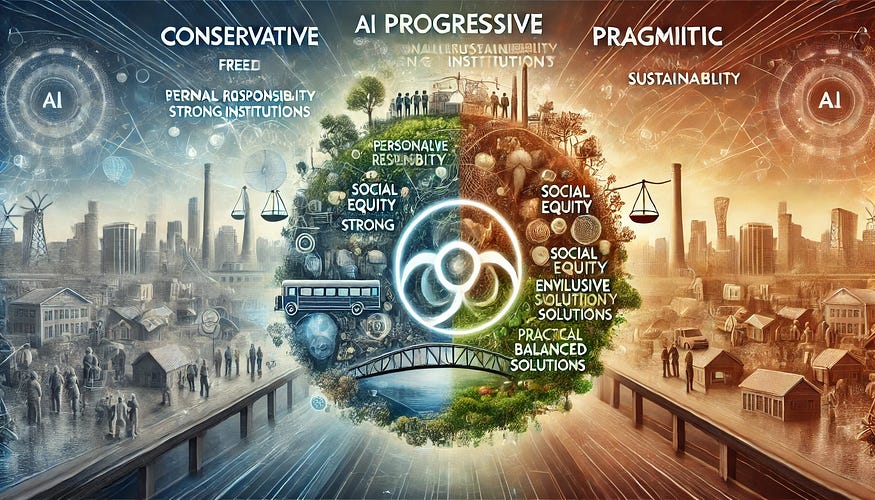
Political and Legal Landscape
1. Balanced Legislation:
Bipartisan Governance: Laws would be crafted through bipartisan efforts, ensuring that both progressive and conservative values are represented. This could lead to more centrist policies that aim to address the concerns of a broad spectrum of citizens.
Supreme Court: The Supreme Court would have a balanced composition, with justices appointed from across the political spectrum to ensure fair and diverse interpretations of the Constitution.
2. Separation of Church and State:
Respect for Diversity: Policies would maintain a clear separation of church and state while respecting religious freedoms and ensuring that secular governance prevails in public institutions.
Inclusive Education: Public education would include a balanced curriculum that respects diverse viewpoints, including comprehensive sex education, climate science, and historical perspectives that cover a range of ideological insights.
Economic and Social Policies
1. Economic Policies:
Moderate Taxation: Tax policies would aim for fairness, combining progressive taxation with incentives for business growth. This could involve tax breaks for small businesses and higher taxes for the ultra-wealthy, balanced with support for job creation and economic development.
Targeted Welfare Programs: Social safety nets would be designed to support those in need while encouraging self-sufficiency and economic participation. Programs like universal basic income could be tested on a smaller scale alongside traditional welfare reforms.
2. Social Issues:
Healthcare: A hybrid healthcare system could emerge, blending elements of universal coverage with private options. This might involve a public option alongside private insurance, aiming to ensure basic healthcare access for all while allowing market competition.
Gender and Identity: Policies would support the rights of all individuals, including transgender and non-binary people, through anti-discrimination laws and inclusive practices, while respecting religious and cultural beliefs.
Cultural and Environmental Policies
1. Cultural Policies:
Balanced Immigration: Immigration policies would focus on both security and inclusivity. This could involve strong border security measures combined with compassionate immigration reform, pathways to citizenship, and protections for refugees.
Responsible Gun Control: Gun rights would be preserved with reasonable regulations to ensure safety. This might include comprehensive background checks, mental health support, and restrictions on high-capacity firearms.
2. Environmental Policies:
Sustainable Development: Environmental policies would aim to balance economic growth with sustainability. This could involve investments in renewable energy, incentives for green businesses, and regulations that protect natural resources while allowing for responsible development.
Environmental Justice: There would be a focus on addressing the disproportionate impact of environmental issues on marginalized communities, ensuring equitable access to clean air, water, and public lands.
Conclusion
In a balanced America where the left, right, and middle ideologies influence governance equally, the result would be a nation characterized by compromise, inclusivity, and pragmatic solutions. This scenario envisions a political environment where:
Bipartisan Collaboration: Legislation is crafted with input from all sides, ensuring diverse perspectives are considered and resulting in more stable and enduring policies.
Economic Fairness: Taxation and welfare systems are designed to support economic growth while reducing inequality and encouraging self-reliance.
Social Inclusivity: Rights and protections are extended to all individuals, respecting diversity and promoting social cohesion.
Balanced Governance: Policies are aimed at maintaining security, sustainability, and prosperity, respecting both individual liberties and collective responsibilities.
Such a balanced approach could lead to a more harmonious society, where the strengths of each ideology are harnessed to create a fair, prosperous, and inclusive nation. However, achieving and maintaining this balance would require ongoing dialogue, mutual respect, and a commitment to the common good.
What approach would better serve humanity as we approach the singularity?
Approaching the Singularity: A Balanced and Inclusive Approach to governance
As humanity approaches the singularity — a point where artificial intelligence (AI) surpasses human intelligence and transforms society — it is crucial to adopt an approach that maximizes benefits and minimizes risks. The singularity presents both unprecedented opportunities for advancement and significant challenges. Here are key principles and strategies that could better serve humanity:
1. Ethical AI Development
Principles:
Transparency: AI development processes should be transparent, allowing for public scrutiny and understanding of how AI systems make decisions.
Accountability: Developers and organizations should be accountable for the actions and outcomes of their AI systems.
Fairness: AI systems should be designed to avoid biases and ensure fair treatment of all individuals, regardless of their background.
Strategies:
Ethics Committees: Establish independent ethics committees to oversee AI development and deployment.
Regulatory Frameworks: Develop comprehensive regulatory frameworks to ensure AI is developed and used ethically.
Public Involvement: Engage the public in discussions about AI ethics and governance to ensure diverse perspectives are considered.
2. Interdisciplinary Collaboration
Principles:
Diverse Expertise: Involve experts from various fields, including computer science, ethics, sociology, and law, in AI development.
Holistic Perspective: Consider the broader social, economic, and cultural implications of AI technology.
Strategies:
Interdisciplinary Teams: Create interdisciplinary teams to work on AI projects, ensuring a well-rounded approach.
Cross-Sector Partnerships: Foster partnerships between academia, industry, government, and civil society to address AI-related challenges collaboratively.
Knowledge Sharing: Promote open access to AI research and findings to facilitate global collaboration and innovation.
3. Inclusive Growth and Education
Principles:
Equity: Ensure that the benefits of AI and technological advancements are equitably distributed.
Lifelong Learning: Promote continuous education and skill development to help individuals adapt to changing job markets and technologies.
Strategies:
Education Reform: Reform education systems to include AI literacy, critical thinking, and digital skills from an early age.
Reskilling Programs: Develop reskilling and upskilling programs to help workers transition to new roles in the evolving economy.
Universal Access: Ensure that all individuals have access to quality education and training opportunities, regardless of their socioeconomic status.
4. Robust Legal and Regulatory Frameworks
Principles:
Protection: Protect individual rights and privacy in the age of AI and big data.
Adaptability: Develop laws and regulations that can adapt to the rapid pace of technological change.
Strategies:
Data Privacy Laws: Implement strong data privacy laws to protect individuals’ personal information.
AI Accountability: Create legal frameworks that hold AI systems and their developers accountable for their actions.
Continuous Review: Regularly review and update regulations to keep pace with technological advancements.
5. Global Cooperation
Principles:
Shared Responsibility: Recognize that the challenges and opportunities of the singularity are global in nature and require international cooperation.
Peace and Stability: Promote the use of AI for global peace, security, and sustainable development.
Strategies:
International Agreements: Develop international agreements and treaties on AI ethics, governance, and safety.
Global Forums: Establish global forums for dialogue and cooperation on AI-related issues.
Shared Resources: Facilitate the sharing of AI research, technologies, and resources across borders to promote equitable development.
6. Human-Centric AI Design
Principles:
Empowerment: Design AI systems that empower individuals and enhance human capabilities.
Well-being: Prioritize human well-being and quality of life in AI development.
Strategies:
User-Centered Design: Involve end-users in the design and testing of AI systems to ensure they meet real needs and preferences.
Well-being Metrics: Develop metrics to measure the impact of AI on human well-being and use these metrics to guide development.
Ethical AI Use: Promote the use of AI in ways that enhance human creativity, collaboration, and overall well-being.
Conclusion
As we approach the singularity, a balanced and inclusive approach to AI development and deployment will be crucial to ensuring that the benefits are maximized and the risks are minimized. By adhering to ethical principles, fostering interdisciplinary collaboration, promoting inclusive growth and education, establishing robust legal frameworks, encouraging global cooperation, and designing human-centric AI systems, humanity can navigate the challenges of the singularity and create a future where technology serves the greater good. This comprehensive approach will help us harness the transformative potential of AI while safeguarding our values and ensuring a fair and equitable society.
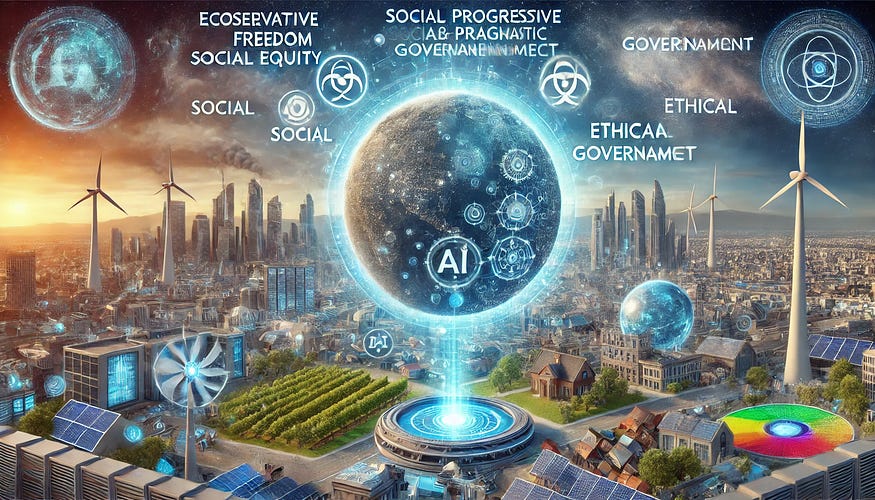
Summary
In “Navigating Governance Ideologies: An AI Perspective on America’s Future,” we explore the potential impact of conservative (right), progressive (left), and pragmatic (middle) governance ideologies on America’s future. By analyzing the hypothetical outcomes of each approach, we highlight the strengths and potential conflicts of each ideology, emphasizing the need for a balanced and collaborative vision for the future.
Conservative Governance Ideology:
Focuses on economic freedom, personal responsibility, and strong institutions.
Emphasizes traditional values, limited government intervention, and free-market principles.
Potential conflicts include reduced recognition of gender diversity and limited environmental initiatives.
Progressive Governance Ideology:
Prioritizes social equity, environmental sustainability, and inclusive growth.
Advocates for comprehensive healthcare, wealth redistribution, and robust social safety nets.
Potential conflicts include opposition from those who prioritize individual liberties and limited government.
Pragmatic Governance Ideology:
Strives for balance and practical solutions, blending the strengths of both conservative and progressive ideologies.
Emphasizes bipartisan collaboration, economic fairness, and social inclusivity.
Seeks to address both security and inclusivity in immigration and responsible gun control.
Approaching the Singularity: A Balanced and Inclusive Approach:
Ethical AI development with transparency, accountability, and fairness.
Interdisciplinary collaboration involving diverse expertise.
Inclusive growth and education to ensure equitable benefits from AI advancements.
Robust legal and regulatory frameworks to protect individual rights and adapt to technological changes.
Global cooperation to address the challenges and opportunities of the singularity.
Human-centric AI design to empower individuals and enhance well-being.
Conclusion
As we approach the singularity, it is crucial to adopt a balanced and inclusive approach to governance and AI development. By integrating the best aspects of conservative, progressive, and pragmatic ideologies, we can create a society that fosters stability, equity, and innovation. This approach requires embracing change, fostering dialogue, and prioritizing ethical considerations in AI deployment.
Governance should be seen as a tool for the betterment of humanity, leveraging AI to enhance human capabilities in an ethical and productive manner. The future of humanity lies in our ability to navigate these complex ideological landscapes, embracing collaboration and compromise to ensure that all individuals can thrive in the new socioeconomic wave brought about by the singularity. By focusing on shared values and common goals, we can create a more harmonious, fair, and prosperous society for all.


